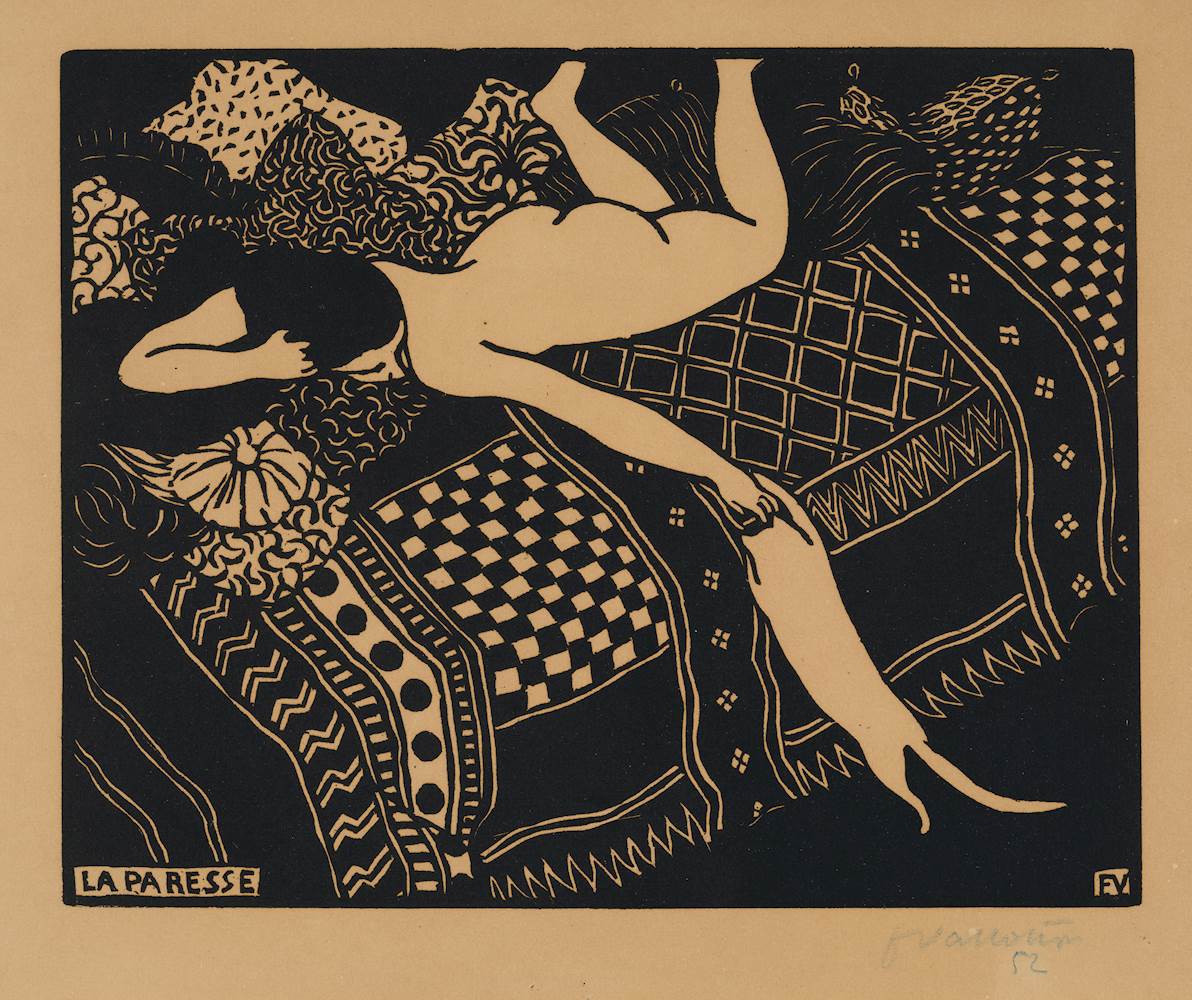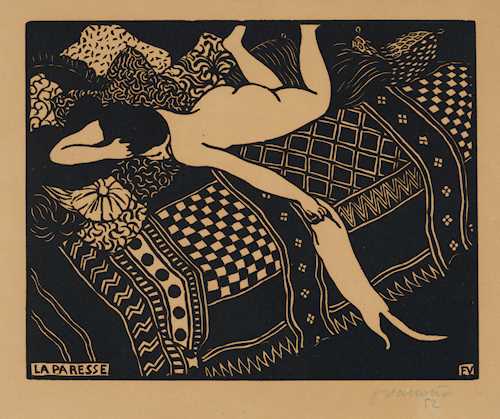
Lot 3608 - A211 Prints & Multiples - Thursday, 28. November 2024, 02.00 PM
FÉLIX VALLOTTON
(Lausanne 1865–1925 Paris)
La Paresse. 1896.
Woodcut. 52/180. Signed in blue crayon lower right: fvallotton, as well as monogrammed in the block lower right: FV, and titled in the block lower left: LA PARESSE. Image 17.8 × 22.3 cm on wove paper 24.8 × 31.8 cm.
Provenance:
Catalog raisonné:
Félix Vallotton's woodcuts, produced between 1890 and 1900, clearly demonstrate his artistic pedigree: they can be seen as the foundation for the fine sense of proportion and line of his later work, as witnessed in the larger format of his paintings. Although the stark black and white of the xylographs could not be further removed from the gentle colour contrasts of his future paintings, his predilection for exploring perspective through surface and spatial depth can already be seen in his prints. What his prints also clearly show is his talent for the reduction of forms down to their most essential element: the line.
His woodcuts are characterised by a timeless clarity, with a graphic quality that makes his images striking and modern to this day, while at the same time often bursting with opulent texture.
His work "La Paresse" from 1896 also shows both of these characteristics: a smooth and shapely body lounges comfortably on a pile of variously patterned cushions scattered on a strikingly designed throw. The figure stretches almost lasciviously towards an equally elongated cat's body. While the luxurious textiles seem almost tangible, the human skin remains a smooth, cool pebble in the centre.
In addition to the interesting arrangement of this scene, however, it becomes immediately apparent that this print conveys more than just the most obvious meaning. As a member of the progressive group "Les Nabis", alongside other artists such as Bonnard and Vuillard, Vallotton was fascinated by metaphors and symbolism. While the title initially suggests a lethargic and lazy person lost in sleepy boredom, the viewer finds a lady playing cheerfully with a kitten. While the body brings to mind the typical female nude, it is probably meant to be less of an erotic nature and more likely to open up associations with more revolutionary depictions such as Ingres's "Grande Odalisque" (1814). Similarly, the manner in which the figure throws her legs in the air seems to convey both a childlike naivety and flirtatiousness. But there is also a clear parallel with the elongated body of the cat: two smooth, light-coloured bodies, separated by fabric that is almost overflowing, but connected by their play. The pattern of the throw placed between the two, which is clearly reminiscent of a chessboard, also points to this game, which can and may be read in a variety of ways. So, while on the one hand there is a cleverly situated art-historical reference with allusions to revolutionary currents of renewal, very much in the spirit of the Nabis, at the same time a veritable potpourri of possible interpretations of the scene opens up.
"La Paresse" is a wonderful work that not only appeals to the eye but also offers an exciting art-historical context. Thanks to Vallotton's timeless symbolic language and his profoundly emblematic subject, this work has lost none of its relevance even after almost 130 years: in today's world of constant accessibility and an increasing sense of entitlement, "La Paresse" can also be an invitation to reflect on the interplay between idleness and relaxation, between the pressure to perform and the need for rest and retreat.
His woodcuts are characterised by a timeless clarity, with a graphic quality that makes his images striking and modern to this day, while at the same time often bursting with opulent texture.
His work "La Paresse" from 1896 also shows both of these characteristics: a smooth and shapely body lounges comfortably on a pile of variously patterned cushions scattered on a strikingly designed throw. The figure stretches almost lasciviously towards an equally elongated cat's body. While the luxurious textiles seem almost tangible, the human skin remains a smooth, cool pebble in the centre.
In addition to the interesting arrangement of this scene, however, it becomes immediately apparent that this print conveys more than just the most obvious meaning. As a member of the progressive group "Les Nabis", alongside other artists such as Bonnard and Vuillard, Vallotton was fascinated by metaphors and symbolism. While the title initially suggests a lethargic and lazy person lost in sleepy boredom, the viewer finds a lady playing cheerfully with a kitten. While the body brings to mind the typical female nude, it is probably meant to be less of an erotic nature and more likely to open up associations with more revolutionary depictions such as Ingres's "Grande Odalisque" (1814). Similarly, the manner in which the figure throws her legs in the air seems to convey both a childlike naivety and flirtatiousness. But there is also a clear parallel with the elongated body of the cat: two smooth, light-coloured bodies, separated by fabric that is almost overflowing, but connected by their play. The pattern of the throw placed between the two, which is clearly reminiscent of a chessboard, also points to this game, which can and may be read in a variety of ways. So, while on the one hand there is a cleverly situated art-historical reference with allusions to revolutionary currents of renewal, very much in the spirit of the Nabis, at the same time a veritable potpourri of possible interpretations of the scene opens up.
"La Paresse" is a wonderful work that not only appeals to the eye but also offers an exciting art-historical context. Thanks to Vallotton's timeless symbolic language and his profoundly emblematic subject, this work has lost none of its relevance even after almost 130 years: in today's world of constant accessibility and an increasing sense of entitlement, "La Paresse" can also be an invitation to reflect on the interplay between idleness and relaxation, between the pressure to perform and the need for rest and retreat.
CHF 20 000 / 30 000 | (€ 20 620 / 30 930)


